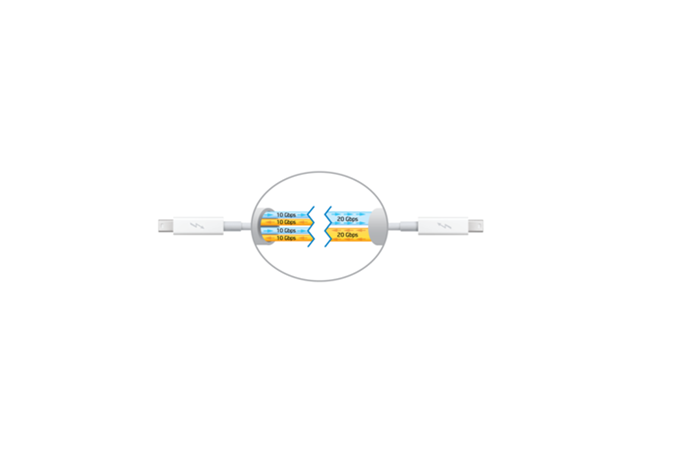Intel Announces Thunderbolt 2 at Computex: 20Gbps Bi-Directional Bandwidth per Channel
by Anand Lal Shimpi on June 4, 2013 7:18 PM EST- Posted in
- CPUs
- Intel
- Thunderbolt
- Trade Shows
- Computex 2013

Earlier this year Intel revealed some details about Falcon Ridge, its 2014 Thunderbolt controller. Today it went a little further and gave the updated Thunderbolt spec a new name: Thunderbolt 2.
New details are scarce unfortunately. Thunderbolt 2 moves to a new 20Gbps bi-directional channel that can handle both data and/or display. Current implementations are limited to 10Gbps per channel for data or display, both can't be sent over the same channel.
Thunderbolt 2 will support DisplayPort 1.2 and 4K video. Intel expects the first Thunderbolt 2 controllers to go into production by the end of this year, and ramp into early 2014. Given the timeframe I no longer believe this is a Broadwell play. It also seems too early for the rumored 9-series chipset refresh. Thunderbolt 2 may end up appearing out of phase with both of those.
Source: Intel










35 Comments
View All Comments
Poik - Tuesday, June 4, 2013 - link
Given the implementation on the new Haswell boards it feels as tho thunderbolt is dead. There's no business case for it right now as you'd be insane to bring out a lot of TB based stuff as outside of Apple there's no support.wicketr - Tuesday, June 4, 2013 - link
Agreed. Until it gets to the point of being really, really fast (PCI Express x16-like) to the point where external graphics cards in a docking station are feasible at comparable speeds, I don't see the point.boeush - Tuesday, June 4, 2013 - link
Seems to me, external graphics card connections would need not just high bandwidth but low latency; I'd almost say that past a certain practical minimum, low latency becomes much more important than higher bandwidth. It's analogous to the characteristics of your internet connection for online gaming: once you get past a certain minimum bandwidth threshold, what starts to matter most is not more bandwidth but lower ping times (i.e. lower 'lag').Unless an entire rendering pipeline including all data and logic can fit into the GPU's on-board memory (and execute purely on the GPU), any communication with CPU and load/stores to DRAM would probably be significantly slower over Thunderbolt than over plain PCI Express (due to extra encoding/decoding steps, and extra length of cable.)
I've seen somewhere that Intel plans to eventually move Thunderbolt to a fiber optic implementation, which would help with transmission latency over the cable (and allow for longer cables), but will probably add extra latency due to optical transceivers... so in the end might be a wash.
A5 - Tuesday, June 4, 2013 - link
If Apple keeps paying them for the controllers, Intel will keep making and developing the chips. Eventually it will be cheap enough to add in to be relevant in the low-margin PC space.Dman23 - Wednesday, June 5, 2013 - link
I completely agree. Once Apple implements Thunderbolt into it's Mac Pro and the prices of the cables / controllers continue to become cheaper, which is already happening, TB will become THE choice when it comes to top-of-the-line Interconnect where getting the fastest and reliable speed is key.Death666Angel - Wednesday, June 5, 2013 - link
So, it goes the Firewire road as many have predicted before. Nothing new. Nothing for me.Dentons - Wednesday, June 5, 2013 - link
The analogy to Firewire is spot on in nearly every respect.Formats without enough technical superiority to warrant their tremendous price premium. That few device makers ever adopt due to pricing. Which is nonetheless championed by a small subset of Mac users, while the rest of the world adopt much cheaper rival that is more than good enough for most.
enealDC - Friday, June 7, 2013 - link
This!CalaverasGrande - Friday, June 7, 2013 - link
Actually Firewire is/was Apple's IP. They charge a licensing fee for every firewire port regardless of whether it is on a pc or mac. TB is Intel's IP. So it probably has a lower fee (if any). I expect Intel is happy just selling the chips and would rather see wider adoption long term, than short term profits.repoman27 - Saturday, June 8, 2013 - link
Actually, FireWire is a trademark held by Apple and freely licensed to third party developers of IEEE 1394 enabled devices who comply with certain guidelines. IEEE 1394 is a serial bus interface standard maintained by the IEEE P1394 Working Group based on an open host controller interface. The standards essential patents required to implement IEEE 1394 are held by 10 corporations including Apple, which was one of the lead designers of the technology, and are licensed as a package by MPEG LA at a rate of 25¢ per finished product, regardless of the number of physical ports.Thunderbolt is a proprietary Intel technology developed at the behest of Apple, which continues to hold certain standard essential patents related to the technology. The Thunderbolt trademark, although originally registered by Apple was transferred to Intel, and licensing and certification are dictated by Intel. This is one of the most glaring differences between FireWire and Thunderbolt. While FireWire may not be an obviously popular consumer interface, it's actually rather ubiquitous due to its open nature and reasonable licensing arrangement. The closed nature of Thunderbolt and Intel's refusal to allow it to become the interoperable standard that Apple had hoped it would be may result in its undoing sooner rather than later.